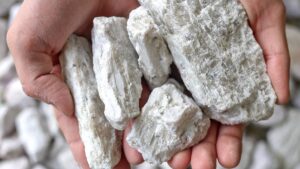Domestic supply key to ensuring critical minerals security

Domestic supply is key to securing critical mineral supply chains. Pic: Getty Images
- Security of critical mineral supply chains is becoming increasingly important
- Customers and governments want to cut over-reliance on a single provider
- Domestic supply of uranium, lithium and rare earths are increasingly sought after
Secure critical mineral supplies remain of incredible importance as regions promote domestic production to alleviate the uncertainties resulting from being reliant on a single provider.
Relying on a single source opens up end users to potential supply chain shocks due to geopolitics, bad weather or accidents at shipping choke points – like the Suez Canal being blocked for six days in March 2021 after a container ship ran aground.
Critical minerals that have taken more than their share of limelight in this push, particularly by Western nations, include – though are certainly not limited to – lithium, rare earth elements (REEs) and uranium.
Lithium – despite experiencing a more than 65% price decline this year – remains valued for its use in lithium-ion batteries while demand for new sources of REEs remains high due to the use of elements such as dysprosium, terbium, neodymium and praseodymium – the magnet REEs – in permanent magnets for electric vehicle motors and wind turbines.
Uranium remains a hot topic despite prices correcting after hitting a peak of over US$107/lb in January.
Citi remains bullish about the energy metal’s prospects, recently forecasting an average price of US$110/lb for 2025, around US$30 above spot.
These three companies are looking to develop local supply chains in the West for lithium, rare earths and uranium in three different regions.
US uranium powerhouse
Uranium is the fuel that powers nuclear reactors and makes up a little more than a quarter of their operating costs.
While demand suffered in the wake of the Fukushima disaster in Japan, this is quickly changing on the back of growing demand for nuclear energy as well as the US move to sanction supplies from Russia.
Speaking to Stockhead, GTI Energy (ASX:GTR) executive director Bruce Lane noted that US nuclear power generators – also known as utilities – have known for some time that uranium and nuclear fuel components from Russia would likely be sanctioned and had pulled forward purchasing to stock up and lock in lower prices on legacy contracts.
“In the immediate short term they seem to be pretty well covered. However, they have likely also been waiting to see how the Russian ban waiver system plays out before acting to secure new long term contracts for fuel,” he added.
“Now that there is more certainty with regards to the ban and the waivers, everyone should know where they stand and US utilities are likely to press on with trying to lock in future supply from local or friendly uranium, conversion and enrichment sources.
“This should be the point where the US uranium miners will start to see ink on paper with the signing of higher priced contracts during the back end of 2024 and into 2025.”
Two years of rising uranium prices means low-cost in-situ recovery miners in Wyoming and Texas are starting to come back online.
“This movement has been kick started by Ur Energy, Encore Energy and UEC who are all back in production, while Peninsula Energy (ASX:PEN) is also due to restart later this year,” Lane added.
“Energy Fuels is back underway with mining for its White Mesa conventional uranium mill at Blanding in Utah and is preparing to restart its Nichols Ranch ISR plant in Wyoming.
“In addition, Anfield Energy and Western Uranium and Vanadium are pressing on with their production plans for mining and conventional milling in Utah and Colorado, so there really is a lot happening.”
While S&P recently noted a significant climb in US domestic uranium production, it still remains a fraction of what US domestic production was in 2018.
Lane concurred, noting that US production was only 84,000lb in the June 2024 quarter, a far cry from the US annual requirement of 50Mlb a year.
“The US produced around 44Mlb of uranium in 1980 before the “Megatons to Megawatts” program kicked in to down blend Russian weapons material for nuclear fuel,” he said.
“This coincided with the rise of Kazakhstan who proceeded to flood the market with cheap ISR pounds resulting in persistent low prices. The US industry was effectively curtailed thereafter for around 40 years due to oversupply and low prices.
“But the US industry is on its way back and the Russian fuel ban is helping, but ultimately what has driven production restarts is better contract prices, so US miners need to secure long-term contracts for meaningful volumes at higher prices in order to fill the utility supply drought.”
Exploration investment is needed to boost domestic uranium production, with GTI’s base of Wyoming the perfect place to focus on due to its large endowment of low cost, sandstone-hosted uranium deposits with simple metallurgy.
Wyoming is also a “self-sanctioning” state for uranium mine permitting and has a long history of uranium mining with seven permitted facilities and operating mines within 100 miles of GTR’s projects.
GTR is the only junior in the state with compliant resource ponds at its Lo Herma ISR project, which already hosts a resource of 5.71Mlb of U3O8 at an average grade of 630 parts per million.
“We think we’ve probably done as much as any company, if not more, to explore in Wyoming over the last four years,” Lane said.
“We’ve joined the Uranium Producers of America, which is the peak industry lobby group and we are doing our best to attract interest from investors by explaining the opportunity.
“It’s pretty compelling to have the world’s largest uranium buyers on your doorstep, with a genuine need to switch back to US supply when we have projects that offer a rapid path to production, with low capex, low opex and negligible environmental impact.
GTI wants to grow the Lo Herma resource ahead of a scoping study late this year or early 2025.
“If all goes well, we will then proceed with the next steps to further grow the resource whilst concurrently moving along the path to permitting the project for development,” Lane said.
“Five years is a long way off but if the uranium price holds up as we expect it to and the industry continues its resurgence then we can see a credible path to development at Lo Herma.
“Maybe that will involve some corporate activity given the industry’s track record of M&A.”
Rare earths in Greenland
China dominates the rare earths sector, producing 60% of raw materials and a massive 90% of refined material. So it is unsurprising the European Union and US are both keen to develop ex-China supply.
The EU has set ambitious targets, setting itself the goal of domestically mining 10%, recycling 25% and processing 40% of its annual needs by 2030, expected to increase six-fold over current levels.
It plans to form a “Critical Raw Materials Club” for like-minded countries willing to strengthen global supply chains, strengthen the World Trade Organisation, expand its network of sustainable investment facilitation agreements and free trade agreements, as well as enforcement to combat unfair trade practices.
The US government has also announced plans to impose a 25% tariff on REE magnet imports from China from 2026 while its Inflation Reduction Act is aimed at building up domestic supplies of critical minerals by introducing a new tax credit of up to 10% of the manufacturer’s cost of production.
This is backed by the Department of Defense, which is keen to establish a ‘mine-to-magnet’ supply chain for REEs – also essential components in a range of defence applications.
Against this backdrop, the EU and the US will welcome a source of REEs that sits right on their doorstep.
This is exactly what European Lithium (ASX:EUR) is bringing to the table.
The company is best known for holding the majority stake in Nasdaq-listed Critical Minerals Corp (CRML), which in turn owns the Wolfsberg lithium project in Austria.
However, CRML also owns a 42% interest in the giant Tanbreez REE deposit in Greenland, a 4.7 billion tonne resource that includes 28.2Mt of contained REEs with valuable heavy REEs making up more than 25% of the total rare earth oxide content. That makes it one of the world’s largest REE deposits.
The fully permitted South Greenland project boasts exposure to three major products including eudialyte (soluble REE, zirconium, and tantalum), arfvedsonite, and feldspar.
The resource is well understood, having been defined by 414 drill holes and more than 366,000 assays completed along with testing of a ~709t bulk sample.
Its shallow nature means that a potential open pit operation with minimal waste would be most suited while its location grants it year-round direct shipping access via deep water fjords connected to the North Atlantic Ocean.
Canadian lithium hub
Canada has been a rising star in the lithium sector for some time now and for good reason.
Not only does the country have rich lithium deposits spread out over several states and territories, it also has an advanced and robust mining industry paired with a supportive regime.
Highlighting the latter, the Canadian Government has introduced legislation such as the 2022 Critical Minerals Strategy in December 2022 that offered up to C$4bn to support investments across the critical minerals supply chain.
This included a 30% tax credit – the Critical Mineral Exploration Tax Credit – to people investing in flow-through shares in mining companies’ exploration activities for specified critical minerals that are necessary to develop clean technologies.
Canadian operations are also likely to be beneficiaries of the US IRA.
While there are no shortage of ASX companies that are seeking lithium resources in the country – including standouts such as Sayona Mining (ASX:SYA) and Piedmont Lithium (ASX:PLL) with their producing North American Lithium operation – Lithium Universe (ASX:LU7) has a more ambitious strategy than most juniors.
Rather than go the traditional route of first finding then developing a resource, the company has opted to head downstream and develop a lithium refinery that will capture feedstock from the burgeoning James Bay lithium district.
LU7’s planned Bécancour lithium refinery is expected to have the capacity to produce 16,000tpa of battery-grade lithium carbonate.
It forms a key part of its proposed Québec Lithium Processing Hub, which itself will operate as an independent concentrator with the capacity to produce 1Mtpa.
This will provide resource owners in the James Bay district, where more than 500Mt of economic lithium resources have been proven to date, a valuable option for processing their ore.
It will also rather neatly help to fill a lithium conversion capacity gap that the company has identified in the North American market.
The chosen process is based on China’s Jiangsu plant, first developed by Galaxy Resources under the watch of LU7 chair Iggy Tan. Ongoing metallurgical test work has shown the process is capable of handling the various spodumene types tested to date, aligning with the company’s plan to be third-party processor.
At Stockhead, we tell it like it is. While GTI Energy, European Lithium and Lithium Universe are Stockhead advertisers, they did not sponsor this article.
Related Topics

UNLOCK INSIGHTS
Discover the untold stories of emerging ASX stocks.
Daily news and expert analysis, it's free to subscribe.
By proceeding, you confirm you understand that we handle personal information in accordance with our Privacy Policy.








